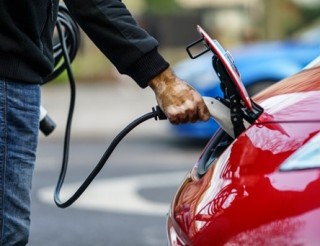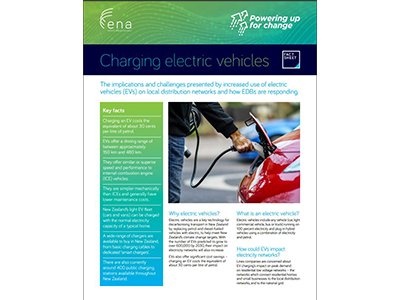Charging electric vehicles
21 June 2022
The implications and challenges presented by increased use of electric vehicles (EVs) on local distribution networks and how EDBs are responding
Key facts
- Charging an EV costs the equivalent of about 30 cents per litre of petrol.
- EVs offer a driving range of between approximately 150 km and 480 km.
- They offer similar or superior speed and performance to internal combustion engine (ICE) vehicles.
- They are simpler mechanically than ICEs and generally have lower maintenance costs.
- New Zealand’s light EV fleet (cars and vans) can be charged with the normal electricity capacity of a typical home.
- A wide range of chargers are available to buy in New Zealand, from basic charging cables to dedicated ‘smart chargers’.
- There are also currently around 400 public charging stations available throughout New Zealand.
Why electric vehicles?
Electric vehicles are a key technology for decarbonising transport in New Zealand by replacing petrol-and diesel-fueled vehicles with electric, to help meet New Zealand’s climate change targets. With the number of EVs predicted to grow to over 600,000 by 2030, their impact on electricity networks will also increase.
EVs also offer significant cost savings – charging an EV costs the equivalent of about 30 cents per litre of petrol.
What is an electric vehicle?
Electric vehicles include any vehicle (car, light commercial vehicle, bus or truck) running on 100 percent electricity and plug-in hybrid vehicles using a combination of electricity and petrol.
How could EVs impact electricity networks?
Lines companies are concerned about EV charging’s impact on peak demand in residential low voltage networks – the networks which connect residential homes and small businesses to the local distribution networks, and to the national grid.
Charging options
The simplest and slowest EV charging uses a cable and a standard 3-pin socket. Dedicated chargers are much faster (and therefore have shorter overall charging periods) but also create a higher level of demand during charging.
Public charging stations, for example at supermarkets and on highways, often have very rapid charging and therefore draw considerably more power than even ‘fast’ home chargers. These are usually installed by public or commercial entities in consultation with local lines companies to ensure the stations are located in the best place for managing the network’s capacity.
What are lines companies doing to prepare?
Research into charging preferences
Lines companies are researching EV owners’ behaviour and preferences for charging. For instance, are most people using plug in chargers or dedicated chargers? Are they fully charging their EVs every evening, or only when the batteries are low, or only every few days?
With the owner’s permission, smart chargers could be controlled remotely by lines companies, allowing, for example, charging to be timed for off peak periods.
In future, lines companies, with the consent of owners, could have the ability to draw available power from an EV battery back into the network to smooth periods of peak demand. EV owners would be compensated for allowing this level of control to lines companies.
Increasing visibility of demand on low voltage networks
Currently, lines companies do not have visibility of the demand and performance of their low voltage networks – the lines that connect to consumers’ premises after the voltage is stepped down via street transformers.
Greater visibility is critical to lines companies being able to safely manage increased or erratic demand on their network as a result of the uptake of EV ownership. Lines companies are actively pursuing projects that will give them the required visibility over these networks to better manage demand.



